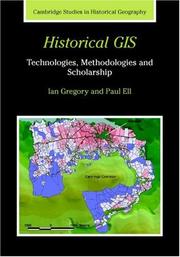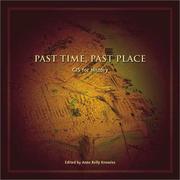| Listing 1 - 10 of 13 | << page >> |
Sort by
|
Book
Year: 2014 Publisher: Calgary [Alberta] : University of Calgary Press,
Abstract | Keywords | Export | Availability | Bookmark
 Loading...
Loading...Choose an application
- Reference Manager
- EndNote
- RefWorks (Direct export to RefWorks)
Fundamentally concerned with place, and our ability to understand human relationships with environment over time, Historical Geographic Information Systems (HGIS) as a tool and a subject has direct bearing for the study of contemporary environmental issues and realities. To date, HGIS projects in Canada are few and publications that discuss these projects directly even fewer. This book brings together case studies of HGIS projects in historical geography, social and cultural history, and environmental history from Canada's diverse regions. Projects include religion and ethnicity, migration, indigenous land practices, rebuilding a nineteenth-century neighborhood, and working with Google Earth.
Historical geographic information systems --- History --- Data processing. --- Canada --- Historical geography.
Book
Year: 2014 Publisher: Calgary [Alberta] : University of Calgary Press,
Abstract | Keywords | Export | Availability | Bookmark
 Loading...
Loading...Choose an application
- Reference Manager
- EndNote
- RefWorks (Direct export to RefWorks)
Fundamentally concerned with place, and our ability to understand human relationships with environment over time, Historical Geographic Information Systems (HGIS) as a tool and a subject has direct bearing for the study of contemporary environmental issues and realities. To date, HGIS projects in Canada are few and publications that discuss these projects directly even fewer. This book brings together case studies of HGIS projects in historical geography, social and cultural history, and environmental history from Canada's diverse regions. Projects include religion and ethnicity, migration, indigenous land practices, rebuilding a nineteenth-century neighborhood, and working with Google Earth.
Historical geographic information systems --- History --- Data processing. --- Canada --- Historical geography.
Book
Year: 2014 Publisher: Calgary [Alberta] : University of Calgary Press,
Abstract | Keywords | Export | Availability | Bookmark
 Loading...
Loading...Choose an application
- Reference Manager
- EndNote
- RefWorks (Direct export to RefWorks)
Fundamentally concerned with place, and our ability to understand human relationships with environment over time, Historical Geographic Information Systems (HGIS) as a tool and a subject has direct bearing for the study of contemporary environmental issues and realities. To date, HGIS projects in Canada are few and publications that discuss these projects directly even fewer. This book brings together case studies of HGIS projects in historical geography, social and cultural history, and environmental history from Canada's diverse regions. Projects include religion and ethnicity, migration, indigenous land practices, rebuilding a nineteenth-century neighborhood, and working with Google Earth.
Historical geographic information systems --- History --- Data processing. --- Canada --- Historical geography.

ISBN: 9780521855631 9780521671705 9780511493645 9780511378782 0511378785 0511493649 9780511372698 0511372698 9780511375309 0511375301 0511377894 9780511377891 1281243329 9781281243324 0521671701 0521855632 1107176859 9786611243326 0511376987 0511376049 0511374542 9780511376047 Year: 2007 Publisher: Cambridge : Cambridge University Press,
Abstract | Keywords | Export | Availability | Bookmark
 Loading...
Loading...Choose an application
- Reference Manager
- EndNote
- RefWorks (Direct export to RefWorks)
Historical GIS is an emerging field that uses Geographical Information Systems (GIS) to research the geographies of the past. Ian Gregory and Paul Ell's study, first published in 2007, comprehensively defines this field, exploring all aspects of using GIS in historical research. A GIS is a form of database in which every item of data is linked to a spatial location. This technology offers unparalleled opportunities to add insight and rejuvenate historical research through the ability to identify and use the geographical characteristics of data. Historical GIS introduces the basic concepts and tools underpinning GIS technology, describing and critically assessing the visualisation, analytical and e-science methodologies that it enables and examining key scholarship where GIS has been used to enhance research debates. The result is a clear agenda charting how GIS will develop as one of the most important approaches to scholarship in historical geography.
Geography --- History as a science --- TECHNOLOGY & ENGINEERING / Remote Sensing & Geographic Information Systems. --- Historical geographic information systems. --- Historical geography --- Geography, Historical --- HGIS (Historical geographic information systems) --- Historical GIS (Geographic information systems) --- Geographic information systems --- Methodology. --- Earth Sciences

ISBN: 9781589480131 1589480139 Year: 2008 Publisher: Redlands, Calif. : ESRI Press,
Abstract | Keywords | Export | Availability | Bookmark
 Loading...
Loading...Choose an application
- Reference Manager
- EndNote
- RefWorks (Direct export to RefWorks)

ISBN: 1589480325 Year: 2002 Publisher: Redlands (Calif.) : ESRI,
Abstract | Keywords | Export | Availability | Bookmark
 Loading...
Loading...Choose an application
- Reference Manager
- EndNote
- RefWorks (Direct export to RefWorks)
Encompassing a broad range of history -- from the Greek and Roman eras to the Salem witch trials and the Dust Bowl of the early 20th century, leading scholars from the United States, Canada, and Great Britain analyze history with the tools of GIS. Through the use of modern GIS technology the past is revealed in new ways, in re-creating Civil War battlefields, by bringing ancient landscapes back to life, and in re-examining long-held assumptions about historical events. Combining a deep appreciation of the strengths of traditional history with the technology of GIS, this book provides a new perspective for historical researchers and GIS experts.
Social geography --- Information systems --- History as a science --- Historical geographic information systems. --- Historical geography --- Geografie --- Methodology. --- Geografische Informatie Systemen --- Toepassingen. --- Historical geographic information systems --- Geography, Historical --- Geography --- HGIS (Historical geographic information systems) --- Historical GIS (Geographic information systems) --- Geographic information systems --- Methodology
Book
ISBN: 9789068094183 Year: 2008 Publisher: Utrecht Koninklijk Nederlands Aardrijkskundig Genootschap
Abstract | Keywords | Export | Availability | Bookmark
 Loading...
Loading...Choose an application
- Reference Manager
- EndNote
- RefWorks (Direct export to RefWorks)
GIS (geografisch informatiesysteem) --- Physical geography --- geographic information systems --- History as a science --- Delfland-Schieland --- Historical geographic information systems --- Geografie --- Landschapskunde --- Historische geografie --- Algemeen. --- Delfland
Book
ISBN: 9088902453 Year: 2014 Publisher: Sidestone Press
Abstract | Keywords | Export | Availability | Bookmark
 Loading...
Loading...Choose an application
- Reference Manager
- EndNote
- RefWorks (Direct export to RefWorks)
Commerce --- Commerce, Prehistoric --- Commerce, Prehistoric --- Commerce, Prehistoric --- Civilization, Ancient. --- Trade routes --- Trade routes --- Trade routes --- Historical geographic information systems. --- History --- History. --- History. --- History.
Book
ISBN: 9781407313627 1407313622 Year: 2015 Publisher: Oxford : Archaeopress,
Abstract | Keywords | Export | Availability | Bookmark
 Loading...
Loading...Choose an application
- Reference Manager
- EndNote
- RefWorks (Direct export to RefWorks)
Historical geographic information systems --- Geospatial data. --- Geomatics. --- Cultural property --- Historic sites --- Systèmes d'information géographique historique --- Données géospatiales --- Geomatique --- Biens culturels --- Lieux historiques --- Protection. --- Conservation and restoration. --- Protection --- Conservation et restauration
Book
ISBN: 3030375692 3030375684 Year: 2020 Publisher: Cham : Springer International Publishing : Imprint: Springer,
Abstract | Keywords | Export | Availability | Bookmark
 Loading...
Loading...Choose an application
- Reference Manager
- EndNote
- RefWorks (Direct export to RefWorks)
This book illustrates how literature, history and geographical analysis complement and enrich each other’s disciplinary endeavors. The Hun-Lenox Globe, constructed in 1510, contains the Latin phrase 'Hic sunt dracones' ('Here be dragons'), warning sailors of the dangers of drifting into uncharted waters. Nearly half a millennium earlier, the practice of ‘earth-writing’ (geographia) emerged from the cloisters of the great library of Alexandria, as a discipline blending the twin pursuits of Strabo’s poetic impression of places, and Herodotus’ chronicles of events and cultures. Eratosthenes, a librarian at Alexandria, and the mathematician Ptolemy employed geometry as another language with which to pursue ‘earth-writing’. From this ancient, East Mediterranean fount, the streams of literary perception, historical record and geographical analysis (phenomenological and Euclidean) found confluence. The aim of this collection is to recover such means and seek the fount of such rich waters, by exploring relations between historical geography, geographic information science (GIS) / geoscience, and textual analysis. The book discusses and illustrates current case studies, trends and discourses in European, American and Asian spheres, where historical geography is practiced in concert with human and physical applications of GIS (and the broader geosciences) and the analysis of text - broadly conceived as archival, literary, historical, cultural, climatic, scientific, digital, cinematic and media. Time as a multi-scaled concept (again, broadly conceived) is the pivot around which the interdisciplinary contributions to this volume revolve. In The Landscape of Time (2002) the historian John Lewis Gaddis posits: “What if we were to think of history as a kind of mapping?” He links the ancient practice of mapmaking with the three-part conception of time (past, present, and future). Gaddis presents the practices of cartography and historical narrative as attempts to manage infinitely complex subjects by imposing abstract grids to frame the phenomena being examined— longitude and latitude to frame landscapes and, occidental and oriental temporal scales to frame timescapes. Gaddis contends that if the past is a landscape and history is the way we represent it, then it follows that pattern recognition constitutes a primary form of human perception, one that can be parsed empirically, statistically and phenomenologically. In turn, this volume reasons that literary, historical, cartographical, scientific, mathematical, and counterfactual narratives create their own spatio-temporal frames of reference. Confluences between the poetic and the positivistic; the empirical and the impressionistic; the epic and the episodic; and the chronologic and the chorologic, can be identified and studied by integrating practices in historical geography, GIScience / geoscience and textual analysis. As a result, new perceptions and insights, facilitating further avenues of scholarship into uncharted waters emerge. The various ways in which geographical, historical and textual perspectives are hermeneutically woven together in this volume illuminates the different methods with which to explore terrae incognitaes of knowledge beyond the shores of their own separate disciplinary islands.
Historical geography. --- Geographical information systems. --- Epistemology. --- Marine sciences. --- Freshwater. --- Culture—Study and teaching. --- Literature—History and criticism. --- Historical Geography. --- Geographical Information Systems/Cartography. --- Marine & Freshwater Sciences. --- Cultural and Media Studies, general. --- Literary History. --- Fresh waters --- Freshwater --- Freshwaters --- Inland water --- Inland waters --- Water --- Ocean sciences --- Aquatic sciences --- Epistemology --- Theory of knowledge --- Philosophy --- Psychology --- Geographical information systems --- GIS (Information systems) --- Information storage and retrieval systems --- Geography, Historical --- Geography --- Historical geographic information systems. --- HGIS (Historical geographic information systems) --- Historical GIS (Geographic information systems) --- Geographic information systems
| Listing 1 - 10 of 13 | << page >> |
Sort by
|

 Search
Search Feedback
Feedback About
About Help
Help News
News